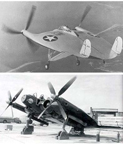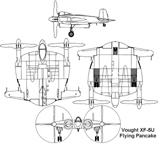January, 1947

Vought XF5U "Flying Flapjack"
Model Airplane News Cover Art for January, 1947
by Jo Kotula
Click to Enlarge
The Vought XF5U "Flying Flapjack" was an experimental U.S. Navy fighter aircraft designed by Charles H. Zimmerman during World War II. This unorthodox design consisted of a flat, somewhat disc shaped body ("discoidal") serving as the lifting surface. Two piston engines buried in the body drove propellers located on the leading edge at the wingtips. The F5U was a "developed" version of the original wood-and-canvas V-173 prototype.




Charles Zimmerman Patent for the V-173/F5U



Vought XF5U "Flying Flapjack" and V-173 "Flying Pancake"
Zimmerman Patent No. 2,481,379
Click to Enlarge
In the 1930s, Charles Zimmerman, a noted aeronautical engineer, advocated the concept of "discoidal" aircraft, the so-called "Zimmer's Skimmers" and worked on a variety of projects on his own and with the Vought company. After testing using scale models, including a remotely controlled, electrically powered large scale model, designated the Vought V-162, the US Navy approached Zimmerman and offered to fund further development.

Mechanix Illustrated Takes You Inside the Flying Flapjack
From the May, 1947 issue
Click here to read the entire article
Click to Enlarge
Data and concept documentation was given to the Navy in 1939, with wind tunnel tests on full scale models being completed in 1940-1941. The original prototype, designated the V-173 (Flying Pancake), was built of wood and canvas. It was designed as a "proof-of-concept" prototype, as shown in the patent diagrams. Here is a video of early experiments with the V-173:
The XF5U-1 was a larger aircraft. Of all-metal construction, it was almost five times heavier than the V-173, with two 1,600 hp Pratt & Whitney R-2000 radial engines. The configuration was designed to create a low aspect ratio aircraft with low takeoff and landing speeds but high top speed. The XF5U design was promising with the ability to hover like a helicopter while having an airspeed range of 0 to 550 mph. However, it came at the time when the United States Navy was switching from propeller to jet propelled. By 1946, the XF5U-1 project was already long over its expected development time, and well over budget. The Navy canceled the project in early 1947, not long after it appeared on the cover of Model Airplane News.
Here is a video of the Vought XF5U "Flying Flapjack":
Click here for more information about the prototype V-173; Click Here for more information about the Vought XF5U "Flying Flapjack".

Click to go back and select another cover.
Counter for the Entire Site (not just this page..)
Home | About Lindy | Last Week's Reviews | Upcoming Events | 1940s Collecibles
The Guide - Establishments - Travel - Accessories
Music | Links | Photo Gallery | Extras | Contact